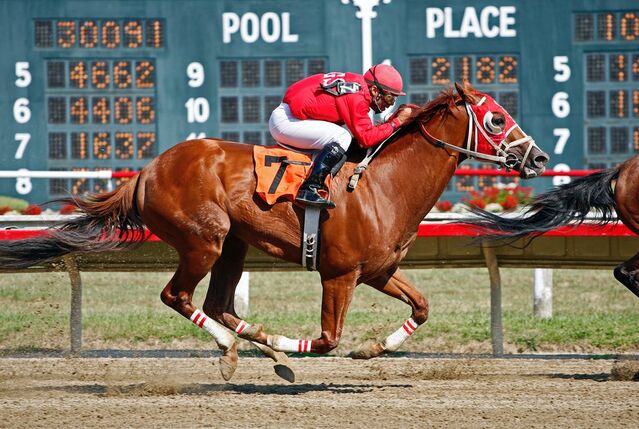Ethics and Morality
How Horse Racing Must Change
A few solutions to problems on the track.
Posted April 14, 2022 Reviewed by Vanessa Lancaster
Key points
- We can create and enforce laws that benefit racehorses.
- We can limit stud fees and reproductive use of racehorse stallions.
- We can root out harm to racehorses, but support humane forms of racing.
- We can make horse racing an ethical sport.
Last month, I described problems that endanger horses and jockeys in the sport of horse racing. Basically, very young horses are raced long before they are physically mature, leading to injuries that are masked by pain relievers. In addition, performance-enhancing drugs are given to many racehorses even when they are sound.
To ensure the psychological morality of using animals for sport, solutions must be put in place to maintain their health and wellness. Fortunately, several solutions are possible—but racing trainers, owners, and spectators will have to insist on them.

With only partial knowledge of the reasons for racing age, injuries, and drugs, several animal activist organizations have called for a halt to horse racing on the grounds that it is unethical. We can solve the problems and maintain the sport ethically by raising the racing age, prohibiting all drugs during racing windows, and enforcing rules by federal law. Some of these suggestions are already under consideration within the sport.
Racing mature horses will reduce injuries dramatically. An adult horse—say, age 6—has solid bones and sturdy joints that are better able to withstand race performance. His feet are large enough to support his height and weight because they have expanded naturally without shoes or extreme concussion during his youth. He has been conditioned over time so that his tendons and ligaments are stronger. In adulthood, the horse’s body is able to handle the twists and turns of his sport.
With injuries reduced by maturity, fewer pain relievers will be needed. There will also be time for the horse to rest and recuperate while medicated. During race windows—say, in the month leading up to a race and during the race itself—no drugs will be allowed in his system.
This practice precludes the need for most performance-enhancing drugs because their effects do not last long enough to accommodate the window. If the horse is injured or becomes ill during the race window and needs to be treated with legitimate veterinary medicine, his race entry will be withdrawn to receive proper treatment, including rest.
Who will enforce such practices? Congress has already begun to solve this part of the problem. In July 2022, the Horseracing Integrity and Safety Act will take effect, requiring the creation of rules and penalties for racehorse doping. They will be enforced by the U.S. Anti-Doping Agency, which supervises a wide variety of human sports (just ask Lance Armstrong). This Act already has the clout to enforce protective medication rules by federal law. It can also enforce penalties for racing horses on deep, slippery mud following (or during) hard rains, which will improve soundness as well.
Altering the age and medication of racehorses will change the game. Owners and trainers will need to keep their charges sound and healthy for three extra years before racing begins. Some trainers will leave the industry. But those who care for the horse’s welfare will stay, hoping to improve equine quality of life and reduce deaths while allowing people from all walks of life to see the immense talent horses can offer. If changed, horse racing can also show society how to care for animals in a safe manner that bolsters sport psychology, showcases talent, and earns money—but also treats all racehorses with dignity.
The greatest impediment to these changes is money. Some people argue that it's too expensive to keep a horse healthy for three extra years until he starts racing at age six. Let's consider that argument. Horse racing is big business with staggering amounts of cash to be won or lost. Secretariat was syndicated for $6 million before winning the Triple Crown in 1973. That’s $39 million today. His race earnings totaled about $1.3 million, which is over $6 million today. But these amounts are only drops in the bucket. A racehorse’s true value is seen in his stud fees.
Stud fees are charges paid for breeding a stallion to a mare. Today's highest known stud fee is $300,000 per impregnation, but unpublished fees are said to reach $700,000. Stallions can continue to breed until about age 30, covering three to four mares a day. The breeding season lasts about four months, but some owners send their stallions to the north and south hemispheres annually to get eight months of annual stud fees.
Let’s add that up. In 2015, American Pharoah’s fee was $200,000. He produces an average of 183 foals per year. That’s $36.6 million per year, not counting paid breeding efforts that did not result in pregnancy. Most stallions can reproduce for about 25 years following their big race wins. Well, hello! This means that over 25 years, Pharoah’s owners stand to receive more than $915 million in stud fees for just one horse. That's far more than enough to keep hundreds of young racehorses for three extra years before they race.
This kind of money encourages owners and trainers to do all the wrong things. Concerned, the Jockey Club is about to begin limiting stallions to breeding 140 mares per yea; still a very large number, but at least it shows that breeding authorities are willing to set limits. Stud fees could be limited as well. There is no need for an owner to earn $915 million from breeding one horse. Surely, $91 million—or $9 million—would do. And a horse could earn that lower amount with his health and soundness intact.
Most horse people are in the business—racing, jumping, breeding, trail-riding, equine therapy, and much more—for one simple reason: We love horses. Horse care demands extensive time and effort over long periods, and most of us barely eke out a living with it.
The vast majority of us do not mistreat or abuse our animals, and we report those few who do. Most performance horses in the United States are pampered daily with green pastures, equine buddies, warm baths, mild exercise, thorough grooming, excellent veterinary care, and top nutrition.
Let’s not allow a few unethical people to fill the news with equine mistreatment while ignoring all the responsible individuals who protect their horses every day.




